WE HAVE
Top Value For You
Sign up for Travelviet VIP membership to enjoy special offers.
Explore the history, culture, people and breathtaking landscape of Vietnam on the Travelviet app
Download the Travelviet app

Specialties in Ha Nam have to try once when traveling and buying as gifts - Is there anything attractive to many tourists? If you are looking for delicious dishes that are both rich in your homeland and suitable for gifts, the list below of Travelviet.net will definitely make you unable to take your eyes off.
Posts with the same theme: Top 9+ tourist destinations in Ha Nam hottest attractive tourists Discover 16 historical monuments in Ha Nam to preserve national culture Traveling in Ha Nam, what to buy as a gift?
Specialties in Ha Nam have to try once when traveling and buying as gifts
Ha Nam tour will not be complete if you ignore famous specialties, both to enjoy and make a meaningful gift for relatives.
Vu Dai village stock
Referring to specialties in Ha Nam, having to try once when traveling, it is impossible not to mention Vu Dai village braised fish. This dish is also known for many other names such as Ha Nam braised fish, Dai Hoang braised fish or Hau Khoan. Not only famous for its rich taste, Vu Dai village's warehouse fish also impressed by the elaborate processing process, the long -standing tradition was preserved for generations.
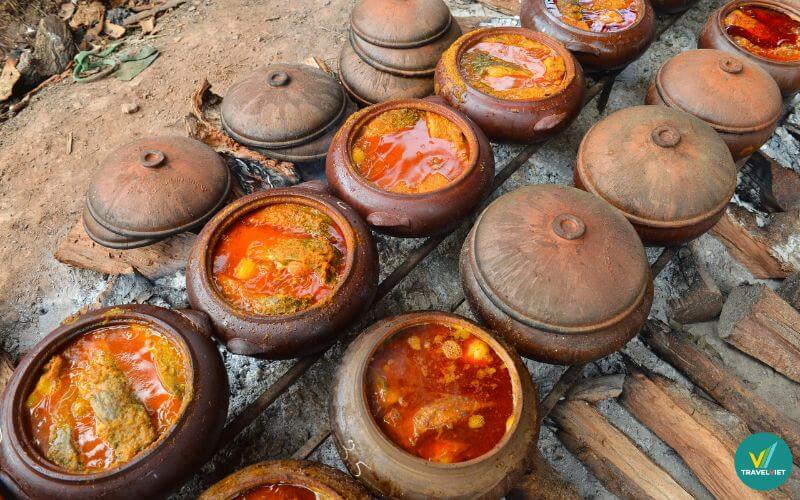
The main ingredient is big black carp, usually weighing from 4–6kg/fish, carefully selected, naturally caught fish or raised in an environment similar to rivers and streams. Fish can be separate or braised with bacon, shrimp, crabs to increase the flavor.
Standard fish pots must be cooked with firewood for hours, solid fish water, soft fish meat, brown cockroach wings eye -catching, no more fishy smell but only the fat, salty taste of traditional spices. Enjoy the pieces of braised fish with a bowl of hot white rice and a little crab soup with spinach, we feel the full soul of Ha Nam's homeland in each taste.
Rolling cake
In the list of specialties in Ha Nam, it must be tried once when traveling and buying as gifts, it is impossible not to mention Phu Ly rolls. The cake is made from eight fragrant oval rice, undergoing the stage of soaking, grinding, meticulously coated to produce soft, white layers of bread. Unlike rolls in many places, Phu Ly rolls are not filled, often served with rolls, spring rolls, onion and sweet and sour fish sauce.
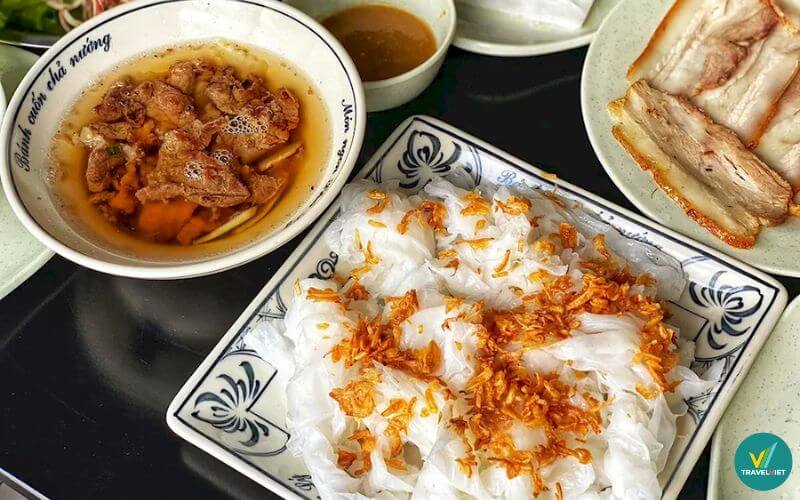
When enjoying hot, the aroma of rice blends with mild fat from the onion fat to create a feeling of irresistible. With only a few tens of thousands of dong, you can enjoy a typical delicious dish of Ha Nam, both simple and rich in the countryside, very suitable to buy as gifts for loved ones.
Corner sauce
Not only famous for the rich fields filled with alluvium all year round, Ha Nam is also the place to produce a unique specialty - Pacific fish sauce. This type of fish sauce is made from delicious fresh fidders living in brackish water such as jar, Kim Bang, Thanh Liem ... through skillful hands and traditional secrets of local people, fermented fermentation naturally to create a fish sauce with an unforgettable typical flavor.
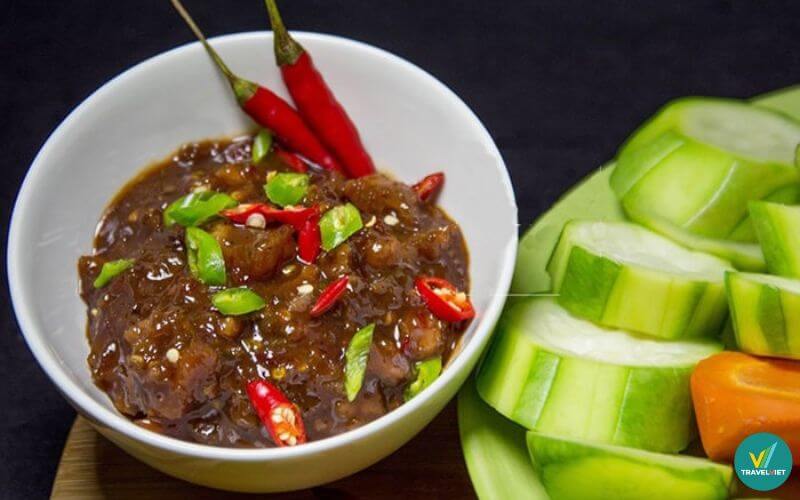
Fish sauce when the finished product is brown with eye -catching cockroach wings, radiating a characteristic aroma with a little pungent and salty taste of the sea. When mixing fish sauce, Ha Nam people often add galangal, crushed ginger, lemon, chili to increase the flavor, use dipping with boiled meat, raw vegetables or rolls, it is delicious "great cat". This is a dish that is not only attractive to indigenous people but also a specialty in Ha Nam to try once when traveling and buying as gifts that make tourists fall in love.
Perch noodle vermicelli
If you are looking for specialties in Ha Nam, you have to try once when traveling and buying as a gift, the perch noodle is definitely the name not to be missed. This familiar dish has a very unique flavor when coming to Ha Nam.
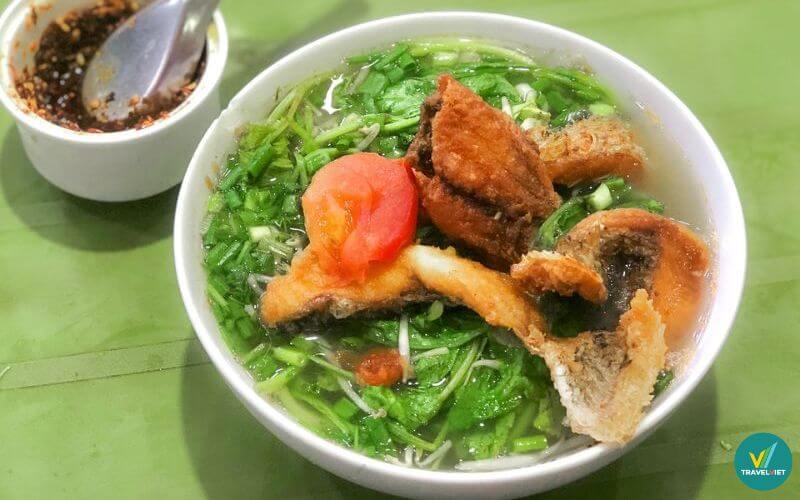
The broth is clear, naturally sweet from the fishbone combined with the crispy fried yellow perch meat, served with vegetables, dill and along the mosquito net, creating a gentle breakfast but rich in the homeland identity. Not only is the delicacy of diners, perch noodles is also a culinary feature that makes people remember Ha Nam forever.
Pale noodles
When it comes to Ha Nam specialties, it is impossible to ignore the vermicelli vermicelli with a long -standing traditional village. The re -canal village is famous for the craft of making noodles, where people have been attached to the profession for generations, creating pure white vermicelli, soft and fragrant rice.
In order to make standard noodles, the worker must be meticulous from the stage of choosing delicious rice, soaked in time, grinding fine flour, molding properly, then steaming, pounding, sieve elaborately according to the traditional secret. It was that sophisticated that made the name vermicelli. Not only is the familiar dish in daily meals, re -canal vermicelli is also the pride of the people here and the specialty of Ha Nam that makes diners from near and far fascinated every time they visit.
Banh Ke Khe
In the journey to discover specialties in Ha Nam, you have to try once when traveling and buying as gifts, do not miss the Banh Ke Khe cake. With the esoteric formula preserved for generations, the cake here has a crispness, a charming aroma and a typical fat taste from sesame, peanuts, coconuts ... Different from the rice cake in many places, the cake is thicker, bigger and strong, making anyone eat once.
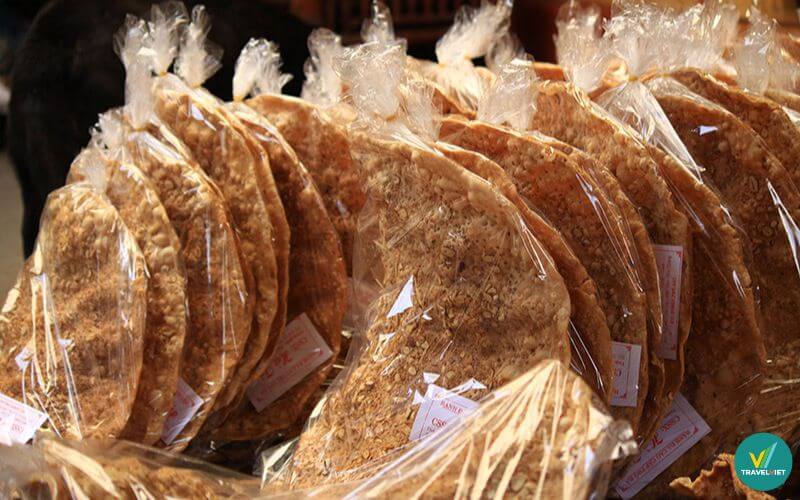
In order to create the perfect batch of cakes, people must meticulously from choosing rice to mix ingredients, sun exposure and proper baked. Thanks to the outstanding quality, the Banh Khe cake is increasingly popular, not only in the locality but also in many provinces such as Hanoi, Ninh Binh, Phu Tho, Thai Nguyen ... This is a rustic but meaningful gift, both delicious and easy to preserve, very suitable to bring back after every trip to Ha Nam.
Brewing wine
In the list of specialties in Ha Nam, it must be tried once when traveling and buying as gifts, Long Tuu is an indispensable name for those who love the traditional wine flavor. This is a famous rice wine of the village, distilled according to the traditional formula is extremely elaborate, using delicious rice with our yeast and 36 rare herbs.
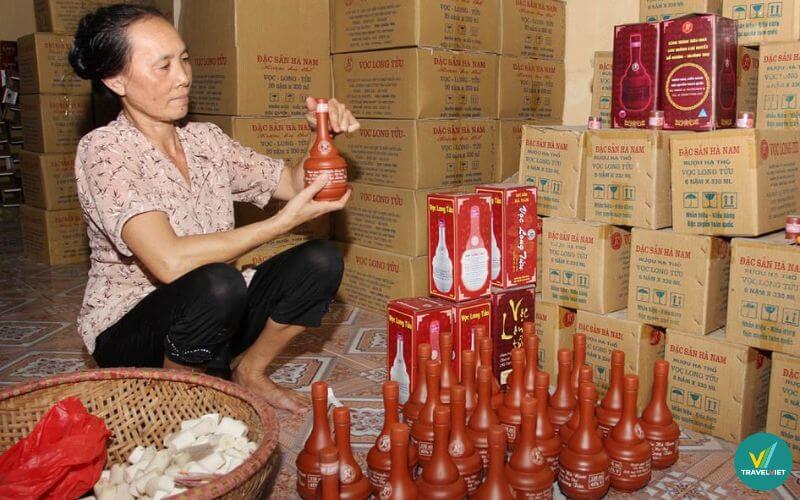
Each stage, from enzyme, cooking rice, to brewing into crockery and distillation requires meticulousness, patience and long experience. The wine after finishing has a faint aroma of the smell of Chinese medicine, the taste is soothing, sweet and sweet in the throat, bringing a warm feeling without harsh.
On the cold winter days, sip a few cups of long -bodies by family tray or with friends at the smoky hotpot will be an unforgettable experience. Not only is the pride of the villagers, Long Tuu is also a rural, sophisticated and meaningful gift for relatives after every visit to Ha Nam.
Banana Ngu Dai Hoang
One of the specialties in Ha Nam had to try once when traveling and buying as a gift is Ngu Dai Hoang banana. A type of banana that was offered to the ancient kings, so it was also called "banana for the king".
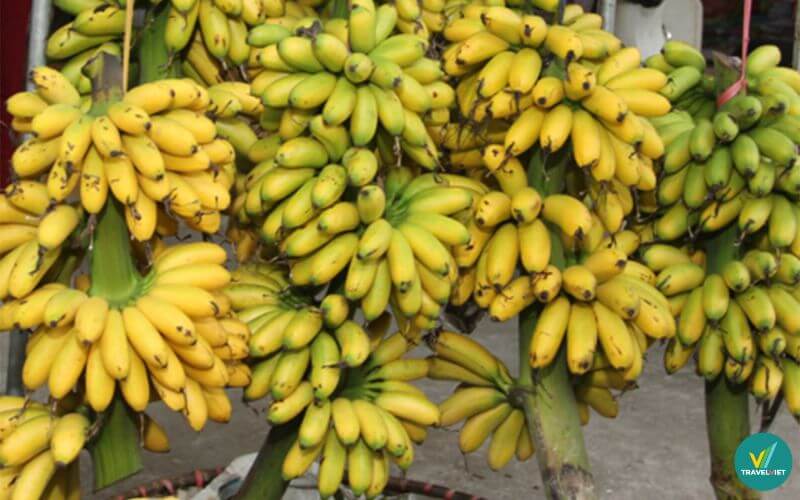
Bananas have golden outer skin, green stalks, small fruits but regularly, the fragrance is faint and the sweetness is very separate. This banana is especially picky, only growing well in the area of the Chau Giang River in Ly Nhan district, where fertile soil and ideal climate.
Not only outstanding because of its beautiful appearance, Ngu Dai Hoang bananas also have high nutritional value with lots of potassium, amino acids, vitamins and minerals good for health. Bananas when ripe can be left for 7–10 days to retain the delicious taste, very suitable for a luxurious gift that is close, with the soul of Ha Nam.
Dam village banh chung
If you are a believer for delicious dishes from glutinous rice, Dam village banh chung is the dish not to be missed when coming to this land. With more than 100 years of traditional, Dam village is proud to be one of the five most famous craft villages in the North, which preserves the full traditional flavor of Vietnamese cuisine.
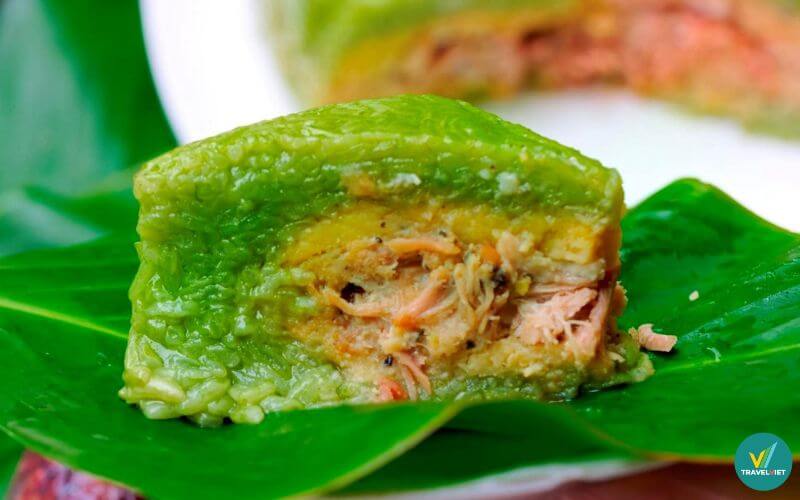
Dam village banh chung is made from precious sticky rice such as Hai Hau sticky rice or combined with yellow flower sticky rice, fragrant green beans and clean pork with a balance rate between lean and fat. In particular, the worker here uses pure rainwater and traditional corrugated iron pot to boil the cake, helping the cake to keep the delicious taste for a long time without rancid, can be left for 8 to 10 days is still soft.
The taste of Dam village banh chung does not stop at the aroma of rice, but also lies in the green beans, pork is marinated and fits well without being sick. It is the feat and enthusiasm in each stage that has turned this folk cake into a culinary symbol of Ha Nam, carrying in itself a whole story of cultural and tradition.
The rice rolls of the village
The village, Ha Nam is famous for crispy crispy spring rolls made from clean rice, 100% natural ingredients and no preservatives. With more than 700 years of traditional years, the rice paper cake has become one of the Ha Nam specialties that visitors have to try and buy as gifts when they have the opportunity.
Mountain goat meat
Ha Nam mountain goat meat is naturally grazed in areas such as Phu Ly, Thanh Liem, Kim Bang, famous for its sweet and nutritious taste. Goat climbing on rocky mountains to eat natural plants, creating firm meat, delicious and unforgettable. When coming to Ha Nam, do not miss the opportunity to enjoy specialties from goats such as re -goats, fried goats, grilled goats or complete with the "7 -dish goat" tray.

Three -star vegetables
Referring to Ha Nam specialties, it is impossible not to mention the three stars, the precious gift of the mountains with sweet, crispy and nutritious taste. The vegetable season lasts from January to April of the lunar calendar, bringing fresh ingredients to process many attractive dishes such as vegetable fish soup, vegetable shrimp or vegetable buds. The rustic but rich taste of vegetables will definitely captivate all diners when coming to Ha Nam.
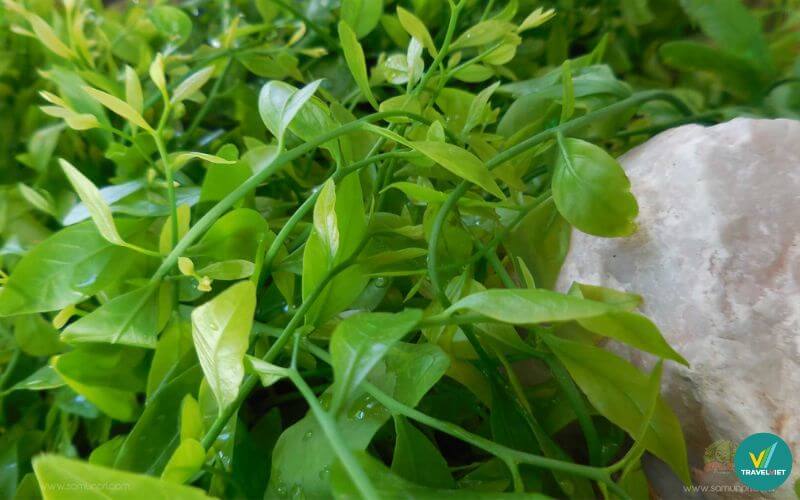
Tangerine Ly Nhan
If you are looking for specialties in Ha Nam, you have to try it once when traveling and buying as gifts, Ly Nhan tangerine is the option not to be missed. Located along the Red River, Ly Nhan district is blessed with fertile soil, ideal climate, creating favorable conditions to plant tangerines to advance the sweet and juicy king.
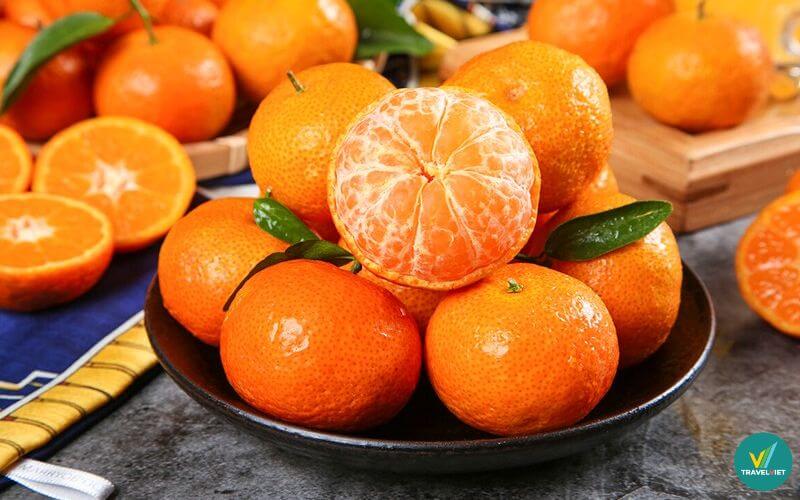
The tangerines are round and golden, which appeals to the taste, a meaningful gift, bearing the homeland flavor to send relatives after each trip. Each tangerine fruit is like a package of the flavor of Ha Nam, making everyone enjoy forever.
Hong Nhan Hau
If you come to Ha Nam but have not enjoyed or bought as gifts for the crispy, sweet pink, sweet and crispy. Different from pink in many other regions, the Hau Hau has big fruits, seedless, thin skin and when ripe turns crimson brilliant but still plump, soft intestine like transparent jelly. The sweet, sweet taste of this pink will make anyone ever tried to remember forever.
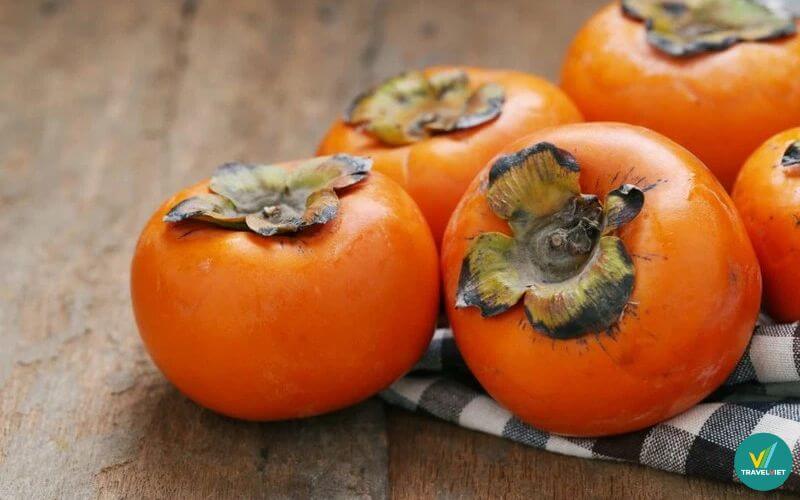
Nha Xa silk
When it comes to traditional craft villages, Nha Xa silk in Ha Nam is one of the specialties in Ha Nam as a gift. With more than 700 years of preserving sophisticated silk weaving, Nha Xa silk stands out with soft, cool and elegant material, with bold Vietnamese traditional culture. This is definitely a meaningful and sophisticated gift for relatives after every trip to Ha Nam.
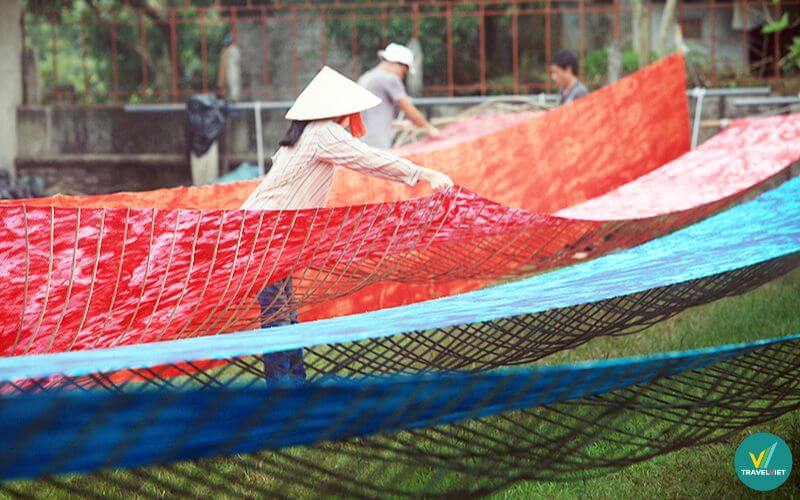
Above are the specialties in Ha Nam to try once when traveling and buying as gifts that you should not miss. Hopefully, you will have great culinary experiences and choose a meaningful gift when coming to this dear land. Wish your trip lots of fun and memorable memories!
Ninh Binh 219 view
Update day : 10/07/2025
Lanh Giang Temple - a famous spiritual destination in Ha Nam, also known by the familiar name Lanh Giang Linh Tu. Specifically, this temple is located in Yen Lac village, Moc Nam commune, Duy Tien district, Ha Nam province. This tourist destination is located right next to the foot of the dike connecting the old Ha Tay, on the right bank of the Red River. Opposite Lanh Giang temple is Hung Yen province. Therefore, visitors can easily get here by many different means, from road to waterway. Because of this location, many people still mistakenly believe that Lanh Giang temple is located in Hung Yen. Ha Nam is a province without an airport, so to get to Lanh Giang temple, visitors can hunt for plane tickets to Hanoi at Traveloka. Traveloka's Fare Notification, Reschedule and Refund features will provide you with maximum support during the booking process. Currently, flights to Hanoi's Noi Bai airport are operated regularly. Therefore, visitors can easily book flight tickets for any period of time. After landing safely at Noi Bai airport, you need to choose the next suitable means of transportation to Ha Nam province. Most tourists often choose bus 206 or some typical bus companies such as Phuc Loc Tho, Viet Trung, Thoi Dai, Man Tinh,... After arriving in Dong Van town, Duy Tien district, tourists who want to visit Lanh Giang temple need to move another 8km along Highway 38 to Hoa Mac town. From here, go another 3 or 4 kilometers and you can reach Yen Lenh bridge. Next, just turn left and follow the road right next to the Red River dyke and you can reach Lanh Giang temple, Ha Nam. According to records from documents, until now, people have not been able to determine the time when Lanh Giang temple was built. According to the inscriptions left on the roof of the second building, it is likely that Lanh Giang temple was restored in 1944. Through historical ups and downs, this temple still retains its original grand scale. Many legends have told that Lanh Giang temple is associated with the Three Famous Gods - the children of the noble lady Hoa Giam. Not only were they instrumental in helping King Hung fight against Thuc Phan's army, but they also supported Princess Tien Dung and her husband. Therefore, Lanh Giang Temple was established to recognize and commemorate the gods who helped King Hung defend the country. Every year, Lanh Giang Temple will have two major festivals to express remembrance to the water gods and pray for good weather all year round so that people can settle down and settle down. The first festival will take place in the 6th lunar month, lasting from the 2nd to the 5th. The second festival will continue to take place in the 8th lunar month, specifically August 20. The festival at Lanh Giang temple not only brings together many extremely sacred and solemn sacrificial rituals and holy processions, but also brings together many interesting and exciting games. Coming to Ha Nam on this occasion, visitors can not only admire the unique landscapes and spiritual architectural works here but can also learn more about the customs and unique culture of Ha Nam. this land. In 1996, Lanh Giang Temple was officially ranked as a national historical and cultural relic by the Ministry of Culture, Sports and Tourism. Since then, the temple has become one of the works that need to be preserved, protected and developed. Lanh Giang Temple consists of 3 buildings with 14 compartments along with a guest house and altar surrounded by solid walls. In the temple there are many valuable items, many precious antiques and statues worshiping the three gods of the Hung King period. Standing in front of Lanh Giang temple, visitors will surely be extremely impressed with the massive and majestic architecture. The Tam Quan gate is designed in the style of a stack of matches with eight roofs, creating a feeling of airiness. The tip of the sword is a beautiful dragon shape interwoven with extremely harmonious motifs. In front of the Tam Quan gate is a calm, blue semicircular lake adorned with colorful and fragrant water lilies. Following the bridge from the temple gate to the middle of the lake, visitors will encounter a tower hidden in the shadow of an old sycamore tree, both majestic, ancient but also extremely poetic.
Ninh Binh 3226 view
From January to December
Tran Thuong Temple is currently a place to honor the national hero Tiet Trung Hung Dao Dai Vuong Tran Quoc Tuan and the generals who fought against the Mongol army in the 13th century. With more than a century of existence, the temple still retains its original beauty and is a symbol of history and pride of the people of Ha Nam. The land of Tran Thuong is known for the saying "Personal Dao, Rice of Tran Thuong" and the poem engraved on the motto at the temple: "The land of Tran Thuong is immense in welfare, bustling with fruits every spring." Previously, Tran Thuong was the center of 6 water canals. From here, you can go up the Red River to Thang Long or down to the sea to the East. Only about 3km from here is where the Tran family's tomb is located. Tran Thuong Temple is one of three major temples worshiping Hung Dao Dai Vuong nationwide. Legend has it that, on his journey against the Mongol army, Tran Hung Dao realized that the terrain here was very dangerous, so he set up 6 food warehouses to serve the war. This place today has become a place to preserve the historical spirit and pride of the people of Ha Nam. Tran Thuong Temple, a majestic and ancient architectural work located on sacred land in the style of "Four water turtles". The overall landscape of the temple includes the outer gate, the inner gate, 5 buildings, 15 compartments, divided into 3 palaces: first, second, third and two hai vu, 5 wells... The architecture and natural landscape of the temple Tran Thuong Temple is like immersing yourself in religion in a sacred cultural space. The value of the temple is reflected in its delicate decoration with unique motifs: two dragons flanking the moon, flying dragons, dancing phoenixes, water waves, clouds and sky... Creating a vivid, ancient picture containing folk philosophy. . The temple's collection of altar objects and ancient books is also very diverse, especially the statue of Saint Tran with a serious face but still a nurturing smile. With traditional historical value, Tran Thuong Temple shines with unique culture. Every year, the temple organizes two major festivals: the Saint Tran food distribution ceremony takes place on the night of January 14 and early morning of January 15; The death anniversary celebration from the 18th to 20th of the 8th lunar month attracts a large number of people and tourists. During the festival, many folk cultural activities are held, from the water procession, the river swimming competition to the "Dong Dong performance" - a traditional ritual, all emphasizing the moral "Remember when drinking water". source". Tran Thuong Temple is not only a place to organize festivals, but also a place to preserve memories of culture, history and beliefs. This is a symbol of respect for the saintly figures who saved the country, the pride of a nation with endless filial piety.
Ninh Binh 3125 view
From January to December
Ha Nam Truc Temple is located in the Truc Temple - Ngu Dong Thi Son tourist area, in Quyen Son village, Thi Son commune, Kim Bang district, more than 7km from Phu Ly city along National Highway 21A. There are many stories about Ha Nam Truc Temple, but according to the old people who took care of the temple, in 1089, on the way to conquer the South through Quyen Son village, Ly Thuong Kiet's war fleet was caught by a sudden wind. blew the mast and swept the flag to the top of Cam Mountain. Feeling strange, he and his generals stopped, preparing to make offerings to heaven and earth, praying for the army's great victory. And that military victory was truly a great victory. Ly Thuong Kiet and his soldiers returned to pay their respects and allowed everyone to celebrate the victory. The festival lasts for months, the atmosphere is jubilant and bustling, and during that time he even taught the people here how to raise silkworms and weave cloth. Later, to commemorate the merits of Ly Thuong Kiet, the villagers built a temple right at the place where he held the festival, which is today's Truc Temple located deep inside the vast green bamboo forest. Truc Temple in Ha Nam is designed in the style of the letter "Dinh" including the temple gate, front hall and harem. The temple gate has 4 pillars: 2 central pillars over 6m high and 2 small pillars on both sides. Truc Temple's front hall is divided into 5 compartments and the harem has 3 compartments, all built in the traditional style of the 17th - 19th centuries: roofed with male tiles, built with interior bricks, exposed to the ceiling, and carved door system. following the themes of four sacred animals, four precious animals... with high artistic value. Not only can you admire the beautiful scenery and participate in the festival, coming to Truc Ha Nam Temple, visitors will also have the opportunity to see with their own eyes stone artifacts from the Ly Dynasty bearing the historical imprint of a heroic time. It is known that currently in Truc Temple, two unresearched antiques from the Ly Dynasty are kept: a pair of dragons and a stone aquarium. The pair of dragons are not very large, located symmetrically vertically, their heads facing the front hall but have different shapes. According to archaeologists who have been here, the dragon on the right, seen from the outside, is a Ly dynasty dragon with a soft, flexible shape; The dragon on the left is the dragon of the Tran Dynasty and has a bigger, stronger and fatter figure. The stone aquarium is made from monolithic stone, has a rectangular, square shape with sharp edges, the bottom of the tank is surrounded by a wave-shaped border, and the tank wall has a four-quarter pattern. Although the exact age of this ornamental tank is unknown, looking at the moss-covered details, one can tell that the tank dates back hundreds of years ago.
Ninh Binh 2927 view
From January to December
If you don't know, zinc drum in Ha Nam is one of the poetic and majestic landscapes. This place includes rivers, mountains, fields, surrounding vegetation, in addition, people create more landscapes to have an overall scenic area as it is today.
Ninh Binh 2550 view
Eight scenes in the mountainous area of Tuong Linh commune (Kim Bang) were once the place where Lord Trinh Sam established his palace and were compared by the lord to eight famous beautiful scenes such as in Tieu Tuong (Yunnan, China). For a long time, the Bat Canh Son range (mountain range with 8 wings) has been considered a scenic spot of Son Nam town. According to Phan Huy Chu's Lich Trieu Chuong Chuong Loai Chi (Du Dia Chi section), in the 16th century, Trinh Doanh's Trinh Doanh came here to admire and likened Bat Canh Son to Tieu Tuong in China and established a palace to go there. about enjoyment. In the past, in Bat Canh Son, there were 8 pagodas and a temple worshiping the great earth spirit, arranged and built according to the theory of the eight trigrams and five elements. Attraction 1: Ong Chua Tien, also known as Ong Pagoda. Ong Chua Tien (Ong Pagoda) was built during the reign of King Tran Nhan Tong on Tuong mountain about 200m. The mountain is the first wall in the Bat Canh Son system in Ha Nam. The pagoda has an extremely sophisticated architectural style with eight battlements and four dragon corners, so this is the first and most important point in the Bat Canh Son landscape. Scenic spot 2: Ong Temple 2. This scenic spot has a large semicircular lake surrounded by rows of deep green trees. The lake has an area of up to 320 acres with green water all year round with an average depth of about 5m. According to legend, this is the lake left by the temple after a flood. Currently in the lake there are countless species of fish that can be exploited. Ong Temple was built in a triangular structure with hundreds of majestic and magnificent Buddha statues. Coming here, you will find your soul more quiet and peaceful. Scenic spot 4: Kieu Pagoda. Kieu Pagoda is located at an altitude of 150m on the mountain of the same name. Kieu Pagoda is located in the Southeast with a large area. The pagoda currently has 3 stele carved into the cliff, which is one of the important features of this place. Besides, the pagoda is also associated with legends about moonlight. Scenic spot 5: Ba pagoda. The pagoda became sacred when the village organized a procession to worship Phap Vu Buddha. Phap Vu Buddha belongs to the Four Dharma system at Dau Pagoda (Bac Ninh) including: Phap Van, Phap Vu, Phap Loi, Phap Dien. History also records the inspiration every time the Ly Dynasty kings came to Dau Pagoda to pray, from then on, pagodas from all over asked to receive the Four Dharmas to worship.
Ninh Binh 3155 view
From January to December
Ba Danh Pagoda is located close to Ngoc Mountain and surrounded on three sides by the Day River. The outside of the pagoda is adjacent to the walking road, the three-entrance gate of the pagoda is near the river bank, so the three-entrance gate is five steps high and the two ends are closed. The three-door pagoda has three compartments, two floors, the upper floor has two layers of roof, roofed with male tiles, around the wooden floor are railings and convenient bars, this floor is used as a bell tower, the lower three compartments have wooden doors. lim. Outside the door are two bronze pillars, on the top of the three-door gate is a pair of flanking dragons. On both sides of the main gate is a small gate with eight roofs and a semicircular curving door. On weekdays, guests enter and exit through the small door, only when there is a ceremony at the temple does the main door open. Ba Danh Pagoda worships Buddha, in addition to Buddha, there are also statues of Thai Thuong Lao Quan, statues of Nam Tao, Bac Dau and worshiping the Four Palaces belief (Phap Van, Phap Vu, Phap Dien, Phap Phong). In particular, the pagoda worships the goddess Phap Vu, the goddess of wind. According to legend, the sacred goddess Phap Vu oversees the control of rain and wind, bringing favorable weather for good harvests and helping people's lives to be prosperous, so the pagoda is called Notre Dame de Danh village, or Pagoda for short. Mrs. Danh. In the central space of the pagoda is a statue of Ba Danh in a meditating position on a shiny black throne with a kind, gentle, feminine and close face. The harmony between the statue and the throne creates the appeal of sculpture art in the Northern Delta. Almost all of the temple's architectural and carving art is concentrated in the worship hall - the place for daily ceremonies. The pavilion has five ironwood compartments, gabled ends and two dragons embossed on it. Observing from the middle of the brick yard, visitors will see a system of embossed statues of "four dragons flanking the moon" on the roof of the street. All four dragons, from their designs to their bodies, are curvy, their eyes, antennae, claws, and fins are very lively, flexible, but also very fierce, looking like they are playing with each other, flying in the vast space. The dragon here carries the colors of the Nguyen Dynasty. At the beginning of the two corridors and adjacent to the worship house are two tall, majestic pillars. On each column are embossed images of four sacred animals: dragon, lyre, tortoise, and phoenix in a symmetrical, harmonious, and balanced position. Every line shows the talent of ancient artisans. Although beautiful and ancient, Ba Danh Pagoda is known for its desolation and desolation. There have been many theories to explain this, but the most convincing is that the pagoda is very sacred, if passersby or people coming to worship, if they laugh, talk loudly, or disrespect even a single sentence, they will be punished. Therefore, pilgrims visit the temple less and less. In addition, the pagoda is located far from residential areas, with few people living around it. Three sides of the pagoda are rivers, forests, and trees, so very few people come to the pagoda, except during major Buddhist festivals. The above reasons have made the already deserted temple even more deserted. Today, the pagoda has been invested and rebuilt to be quite spacious and spacious, with more visitors coming to the pagoda. Therefore, the old saying has now been changed to: "Once upon a time it was quiet and deserted/ Now it is as busy as Ba Danh pagoda." Ba Danh Pagoda currently preserves many rare antiques and ancient books, especially Buddha statues, Bodhisattva statues, great pagodas, stone carvings, parallel sentences and incense sticks...
Ninh Binh 3196 view
From January to December
The temple worshiping King Dinh Tien Hoang, also known as Dinh Bo Linh temple, Van Bong temple or Dai Huu temple (named after the place where the temple is located), currently belongs to Van Bong village, Gia Phuong commune, Gia Vien district, Ninh province. Jar. Legend has it that this is the place associated with the birth of Dinh Bo Linh, a national hero who was instrumental in suppressing the rebellion of 12 warlords, unifying the country, establishing the state of Dai Co Viet in 968. Here, also There are tablets worshiping loyal mandarins who are the four pillars of the Dinh dynasty including Dinh Dien, Nguyen Bac, Trinh Tu, and Luu Co. Legend has it that King Dinh Tien Hoang and his son Dinh Lien were murdered by Do Thich in the year 979. According to court rituals, the royal family conferred the title, beautiful letters, and established a temple to worship in their hometown. Thus, the temple was established long ago. Currently, the rest of the monument has the architectural style of the Nguyen Dynasty. There are many sources of information about King Dinh Tien Hoang, recorded in history and folk legends, and the general tone is to praise his talent and great contributions to the cause of unifying the country and opening up the economy. our country's orthodoxy after thousands of years of slavery. In his homeland today, there are still many legends and places related to the childhood of Dinh Tien Hoang as well as Nguyen Bac, Dinh Dien, famous generals from the same hometown as Dai Huu with King Dinh. Ky Lan Mountain is located at the beginning of Gia Phuong commune, nearly 3km from the temple, with King Dinh's mausoleum, Dai Huu cave, Nguyen Bac's mausoleum. To the southwest of the mountain there is a winding space that looks like a throne, halfway up there is a large, relatively flat area. Legend has it that Mr. Dinh Cong Tru, Dinh Tien Hoang's father, saw the beautiful scene and brought the king's grandfather's grave to this throne, building a mausoleum, called Lang Phat Tich, which has now been renovated. Next to Lang Phat Tich is Dai Huu cave halfway up the mountain. In the cave there are many beautiful shapes formed by stalactites, in some places there are shapes like Ky Lan, so it is also called Ky Lan cave. Previously, according to tradition, the cave had a temple to Son Than, which was the refuge of Mrs. Dam Thi and Dinh Bo Linh when Mr. Dinh Cong Tru passed away, as many books have written. To the southeast of King Dinh's mausoleum, there is also Nguyen Bac's mausoleum. The mausoleum is located next to the foot of the mountain. Right in front of the temple, about 200m away, is Bo De Mound, a tall, square, ancient land area of nearly 200m2 at the beginning of Van Bong hamlet. Legend has it that this is the old house foundation of Dinh Bo Linh. In the middle of the fields of Van Bong village, near the temple of King Dinh Tien Hoang, there is a relatively high area of land, thousands of square meters wide, with the ancient name Dao Ao (also known as Dao Ao land). Legend has it that this place was where Dinh Bo Linh's army gathered for military exercises. In general, the area around the relic today still retains many places and legends related to King Dinh Tien Hoang. These are valuable historical sources to clarify his background and career. Especially from his hometown in Gia Phuong commune today, up to Gia Hung (Gia Vien), to Truong Yen (Hoa Lu), the entire length and width of dozens of kilometers, every land has its own famous places and traditions. theory related to King Dinh Tien Hoang. The temple has been extensively renovated in recent years, but still preserves the ancient Nguyen Dynasty architecture. Facing west, there are three buildings, the architecture is in the style of "first, last". In front of the temple is a semicircular lake. Inside the lake, in the middle of the yard, two bronze pillars were built to form the exit and entrance to the relic. The temple area consists of 3 buildings: Tien Pagoda, Middle Hall and Chinh Tam. The front hall consists of 5 rooms, the architecture is in the style of stacking ironwood beams, and the gable walls are closed. All of the trap heads are carved with leaf patterns, especially the middle part of the trap head is carved with a dragon. The rafters in the truss system are all carved with leaf patterns. The roof of Tien Bai is shaped like two dragons flanking the moon. The middle street is adjacent to Tien Bai, consisting of 3 compartments, architectural style (the entire diaphragm system is located on the rafters), in front there is a door system, all the traps are carved with leaf patterns. In particular, the rafters on both sides of the porch door have quite sophisticated carvings of four sacred animals. The main building consists of 2 main rooms and 1 back room. The architecture is in the style of upper and lower floors. The relic still retains a number of precious artifacts such as worship statues, thrones, altars, and ordinations of dynasties... Every year, on the occasion of the festival of the ancient capital of Hoa Lu, people of Van Bong village and Gia Phuong commune also open Temple festival and participating in the fire palanquin procession from the king's homeland to the ancient capital of Hoa Lu. With outstanding historical and cultural values, the temple of King Dinh Tien Hoang was ranked by the Ministry of Culture and Information as a national historical and cultural relic in 1993. Source: Department of Culture and Sports of Ninh Binh province
Ninh Binh 4186 view
King Le Dai Hanh's mausoleum is located at the foot of Ma Yen mountain to the south, on both sides there are two mountains that people call "Long chau, Ho phu", which are the arms of the throne, so the mountain is also called Hoan Y Son. In the outer citadel area of Hoa Lu Citadel today, it belongs to Yen Thuong Village, Truong Yen Commune, Hoa Lu District, Ninh Binh Province. King Le's mausoleum also has another name according to local people: Ma Quan. This name may come from folk beliefs about the role and position (servant) of Le Hoan during the reign of King Dinh Tien Hoang, however this name is ancient and not very popular. King Le's mausoleum is a type of burial relic, according to the nation's traditional traditions. According to ancient beliefs, the tombs of King Dinh and King Le were all placed in a place called "De Vuong's grave". King Le Dai Hanh, also known as Le Hoan, was formerly talented in martial arts, liberal, and had great ambition. Le Hoan joined the Hoa Lu insurgent army, followed Nam Viet King Dinh Lien to participate in battles, defeated the rebel warlords, and achieved many victories. He was respected by King Dinh Tien Hoang as a wise and brave man and became a Thap Dao general during the Dinh dynasty. Le Hoan led the army to expel the Tong invaders, defeated Champa, and consolidated the independent and unified feudal state apparatus. The government also took care to implement a number of positive measures for economic development. Le Hoan ascended the throne and changed his reign name to Thien Phuc. It can be said that under the reign of King Le Dai Hanh, Hoa Lu Capital and Dai Co Viet country had prosperity and stability. Politics, military, culture, and diplomacy tend to develop, marking important milestones. He deserves to be the person who quelled internal and external enemies, created the country's strength and showed authority to the northern Song Dynasty. In the year At Ty 1005, in March, King Le Dai Hanh passed away at Truong Xuan Palace. When King Le died, his officials buried him and built a mausoleum in the southwest of the foot of Ma Yen mountain. The size of the mausoleum is smaller than that of King Dinh Tien Hoang but still proves the majesty of the emperor. Behind is a stone stele, the main face of the stele has the words: "Le Dai Hanh Emperor's mausoleum" and the date of the stele: Minh Menh's 21st year (1840). According to folk tradition, in the land of Truong Yen, when building the Hoa Lu Capital, King Dinh and King Le both took Ma Yen Son as their criminal record, and took the Dai Van range as the rear of the capital. Ma Yen Mountain is also where the King often resides during every naval review. King Le Dai Hanh's mausoleum was restored in 2020 and is majestic and worthy of the Emperor's stature. The position of King Dinh's mausoleum and King Le's tomb is located in the Hoa Lu ancient capital relic area, attached to central relics such as: Temple of King Dinh - King Le and other nearby relics. In addition to its great historical and cultural value, a place that marks the nation's glory, this is also a place blessed with charming landscapes by nature, attracting tourists from near and far to visit and worship. , paying tribute to great men who have made great contributions to the country. Source: Management Board of Trang An Scenic Landscape Complex
Ninh Binh 4019 view
Bao Loc Temple, My Phuc commune (My Loc) was built on the "wooden ladder" land of An Sinh Vuong Tran Lieu, father of Hung Dao Vuong Tran Quoc Tuan and brother of Tran Thai Tong - the first king of Tran dynasty. During the Tran Dynasty, with the appearance of the Emperor's regime, in 1262, Tuc Mac village was changed to Thien Truong palace and was built on a scale like the second capital after Thang Long. Besides building palaces and magnificent houses for the emperors, the Tran Dynasty also conferred a series of fiefdoms on nobles, surrounding them like a protective belt of Thien Truong. At that time, An Lac hamlet was 2km north of Thien Truong center (as the crow flies). Legend has it that An Lac hamlet is the place where Tran Quoc Tuan was born and raised. With his great contributions in three resistance wars against foreign invaders, in April 1288 he was given the title "National Duke of Hung Dao Great King". When he died, the court re-titled him: "Grand Master, Supreme Patriarch Thuong Quoc Cong Nhan Vu, Hung Dao Great King". Bao Loc Temple was originally built along the Chau River, consisting of three ironwood rooms with tiled roofs. After the river bank eroded, the temple was moved to its current position. Existing on a small scale for a long time, in the early 20th century, Bao Loc temple was raised by people to upgrade it into a solid structure, quite large in size and height. The temple was built according to the design of Dong Phuong Bac Co, but was repaired to suit the traditional architecture of the nation. Construction began in 1928, it took 5 years for the project to be completed. The temple is located in the middle, facing east, on the left is the temple worshiping Buddha, on the right is the palace worshiping the Mother Goddess, behind the temple is Khai Thanh worshiping the king's father, mother, and wife. The entire relic is designed to be symmetrical and harmonious, with airy space creating a feeling of serenity during the holy ceremony. Bao Loc Temple is located in the middle, built in the style of a zigzag letter, including a front hall with 7 wide compartments, a long middle hall with 5 compartments, and a harem with 3 compartments. The architecture of the temple is simple, the columns are made of bricks, many beams are filled with durable and imposing reinforced cement. Although there are not many carvings, scattered in each part there are still themes: four sacred animals, water-rolling dragons, flowers and leaves, pine trees, chrysanthemums, bamboo, apricot trees... In particular, six sets of doors in the harem with plaques. Exquisite carvings bearing the artistic style of the Nguyen Dynasty. In the temple, in addition to the tablets, there are also two statues worshiping Tran Hung Dao (one made of bronze, one made of wood). The bronze statue in a sitting position weighs 4.8 tons, placed in the middle of the street. On both sides there are statues of Hung Vu Vuong Nhien and Pham Ngu Lao, his son and son-in-law. The agarwood statue is placed in the harem, on both sides are statues of literature teachers and martial arts teachers. Khai Thanh Temple is located in the back, the architecture is similar to the main temple but the foundation is 3 meters higher, worshiping Tran Hung Dao's father, mother, wife and two daughters. The worship arrangement here shows the spirit of respect for the teacher, integrity and filial piety of the Great King Hung Dao. Among the relics worshiping Tran Hung Dao, Bao Loc temple has special significance because this land is associated with his childhood. That's why people have the saying "Sinh Kiep Bac, Tran Thuong waterfall, Bao Loc's hometown". Every year, on his death day (August 20 of the lunar calendar), many visitors from all over have the opportunity to attend the traditional Tran Hung Dao festival. Source: Nam Dinh historical and cultural relics
Ninh Binh 3801 view
Nam Dinh Tran Temple relic area is a temple worshiping 14 Tran Dynasty kings, their families and mandarins with meritorious service. This place is also famous for the incense offering ceremony to open the Tran Temple seal in early spring and the Tran Temple Festival in the eighth lunar month every year. The Tran Temple - Nam Dinh relic area includes 3 main architectural works: Thien Truong Temple, Co Trach Temple and Trung Hoa Temple, with a common design and equal scale. In front there is a five-door gate. Through the gate is a rectangular lake. In the middle behind the lake is Thien Truong Temple. Thien Truong Temple, often called Thuong Temple, is located in the center of the Tran Nam Dinh Temple relic area. The temple was built on the foundation of Thai Mieu and Trung Quang Palace of the Tran Dynasty, which was formerly the family temple of the Tran family. Trung Quang Palace is where the Tran Dynasty emperors lived and worked. The current architecture of Thien Truong Temple includes the front hall, middle hall, main altar, incense burner, 2 rows on the left and right, 2 rows on the left and right of the morning glory tube, 2 rows on the left and right of the bamboo tube, 2 rows of the East and West. There are a total of 9 buildings and 31 rooms. The temple frame is built of ironwood, the roof is tiled, and the floor is tiled. The front hall is the place for worshiping and altars of mandarins who had great meritorious service in the Tran Dynasty. In the middle of the hall are the tablets of the 14 Tran Dynasty emperors. The main temple worships the four ancestors of the Tran family, and their wives and royal concubines. The incense burning court (sutra altar) houses the altar and tablets of the Tran Dynasty's officials. Co Trach Temple, often called Ha Temple, is located on the east side of the Tran Nam Dinh Temple relic site. In the front of the hall are tablets of three trusted generals of Tran Hung Dao, Pham Ngo, Pham Ngu Lao and Nguyen Che Nghia. The middle hall worships tablets and statues of Tran Hung Dao, his four sons, Pham Ngu Lao and other generals. The main altar placed the tablets of his parents, Tran Hung Dao and his wife (Princess Thien Thanh), 4 sons and 4 daughters-in-law, daughter and son-in-law. Burn incense (sutras) and place the dragon's temple, inside there is a statue of Tran Hung Dao and 9 Buddha statues. The space left the tablets of Truong Han Sieu, Pham Thien Nhan and Tran Dynasty officials. Thieves placed the tablets of the Tran dynasty's martial gods, Tran Cong and relatives of the Tran family. Trung Hoa Temple is located on the west side of the Tran Temple relic area. The temple was newly built in 2000, on the foundation of the ancient Trung Hoa Palace - where the Tran Dynasty emperors came to consult with the emperors. In Trung Hoa Temple, there are 14 bronze statues of 14 Tran Dynasty emperors placed in the middle hall and main palace. The incense burning court places thrones and tablets to worship the council of mandarins. Fraudulently worshiping civil servants. Fraudsters worship military mandarins. Every year, at the Tran Temple relic site in Nam Dinh, two major festivals will take place, which are the Tran Temple Opening Ceremony in early spring and the Tran Temple Festival in August, attracting a large number of local people and tourists from all over to attend. , grateful for the merits of the 14 Tran kings and praying for good things. Tran Temple is a special and important historical and cultural relic site of Nam Dinh province, ranked by the state as a national historical relic in 2012. Source: Nam Dinh City Electronic Information Portal
Ninh Binh 3764 view
Van Chang communal house is located on the territory of residential group number 16, Van Chang village, Nam Giang town. Van Chang village communal house is a place of worship and gratitude to the local people for the Six Patriarchs of blacksmithing. The genealogy of Van Chang village communal house said that the six craft ancestors together with 15 ancestors from the following families: Doan, Tran, Vu, Nguyen, Do, Ngo... recruited people to explore the fields and develop production. and career expansion. In the Year of the Ox (1373), during the reign of King Tran Due Tong, the reign of Long Khanh 2, after teaching the profession to the people here, the six ancestors returned to their old hometown of Hoa Chang village (Ha Tinh) to continue teaching the profession. forging. To pay tribute to the merits of the ancestors of the profession, local people named the village Hoa Chang - the original hometown of the Patriarchs (during the Nguyen Dynasty, it was changed to Van Chang village); set up a temple to honor: Phuc Than - Six Patriarchs - Tutelary God and take the 15th day of the 11th lunar month, the day the six Patriarchs from Van Chang village returned to their old hometown, as a taboo day. Currently, Van Chang village communal house still retains 6 decrees conferred with the title Khai Dinh 9 (1924) affirming the merits of "Protecting the country", "Ty people" and conferring on the Six Patriarchs: Duc Bao Trung Hung Linh Phu Van Son Saint Ancestor. In addition to the ordinations, Van Chang communal house also preserves many parallel sentences praising the merits and careers of the Six Patriarchs. Currently, along with Van Chang village communal house, Nam Giang town, Nam Truc district, Nam Dinh province worshiping the Six Patriarchs, other localities such as Ha Tinh and Ho Chi Minh City all have places to worship the Patriarchs. forging. Blacksmithing in Van Chang village, Nam Giang town was formed at the end of the 14th century, nearly 7 centuries ago. Initially, blacksmithing was just a side job alongside agricultural production. Through many historical periods, blacksmithing has gradually developed, separating from agriculture to go deeper into specialized production, becoming a traditional handicraft. In 1426, when the Lam Son insurgent army advanced to the North, a young man from the Doan family gathered villagers to stand up to kill the enemy and was awarded the title of Brave General. Knowing that there was a blacksmithing profession here, King Le Loi of Binh Dinh assigned the villagers the task of forging weapons for the insurgent army. Since then, Van Chang forging profession has continuously existed and developed. Also during the period of fighting against the Ming invaders, a group of Van Chang workers came to the Lam Son insurgent army to use the method of forging iron cannon tubes. This type of artillery was a signal for the insurgents to rise up and destroy the enemy. Currently, at Van Chang communal house, two cannons cast in iron are still preserved. During the Nguyen Dynasty, Van Chang blacksmith joined the army, many people were given the title "Tuong Muc", some were given the title "Water Ministry of Water Affairs" as the leader of the soldiers repairing weapons for military barracks, including both the navy and the land army. When the French invaded the North, many Van Chang workers stood in the army and people's ranks against the French. More than 2,000 Can Vuong troops commanded by Dr. Vu Huu Loi (1836 - 1886) were stationed in Giao Cu village (Dong Son, Nam Truc, Nam Dinh), all weapons were produced by blacksmith Van Chang. Up to now, after nearly 7 centuries, the traditional craft of blacksmithing has developed and spread strongly, forming the Nam Giang mechanical industrial cluster. Van Chang blacksmithing and Nam Giang mechanical engineering have become a key local economy, contributing to creating jobs, improving living standards, and building the local economy - culture - society today. a development. With typical values of history and artistic architecture, Van Chang Communal House has been ranked as a National Historical and Architectural Monument in 2018. Source: Nam Truc District People's Committee
Ninh Binh 3721 view
Kha Luong Pagoda and Temple are in Kha Luong village, Ninh Thang commune, Hoa Lu district, Ninh Binh province. The pagoda also has the literal name Thang Lam Tu (Thang Lam Pagoda). Kha Luong Temple has a beautiful terrain located on a turtle-shaped piece of land, in front of the yard is the turtle's mouth, so the villagers do not level it, as a kind of "water tank" where water and blessings gather. Legend has it that the pagoda was built during the Ly Dynasty. During the Nguyen Dynasty, the villagers moved the temple from the site Ma La to the front of the pagoda, creating an architectural style of "Previous Gods, Later Buddhas". The temple has a Dinh harem type structure with a row of columns and a bed to form Tien Duong with three compartments. The harem has three rooms, four rows of ironwood pillars, tiled roofs, outer rafters, mesmerizing rafters, because in the style of gong stands, carved dragons, tigers, and four sacred animals: dragon, lyre, tortoise, phoenix, and lacquer. gorgeous gold plated. The temple is a place to worship the Great King of the Household, who had the merit of saving the villagers from great disaster, was appointed by the House as Great King of the House, and became the Thanh Hoang of Kha Luong village. Kha Luong Pagoda has an architecture in the style of Nhi (=) Tien Duong with five trusses like "upper bed, lower bed", three rows of pillars, hiding a row of columns in the middle, the front row of columns is made of green stone. The Harem or Upper Pagoda has three compartments, rafters like "upper bed, lower bed", three rows of pillars, front and back columns made of green stone, in front there are two stone dragons flanking each other (legend from the Ly dynasty). ). The pagoda worships Tam The, Amitabha Tam, the newborn Sakyamuni, the Holy Monk, and the white-bearded Tho Dia, a folk belief with the wish to bless and protect the people and their village. In addition, the pagoda also worships Han Lam, which is a place to worship ghosts, this is also an ancient worship of the good nature of the people. Every year, Kha Luong Pagoda and Temple take place many forms of cultural activities such as the festival commemorating King Tran Thai Tong, the day of forgiveness for the dead, the holy day of Shakyamuni Buddha, in addition to the days of Wednesday, Full Moon, and New Year. Every villager burns incense and worships. The relic through the ages is also the place where many local revolutionary events took place. During the resistance war against the French, the pagoda was a treatment facility for wounded soldiers, and the pagoda was also an evacuation site for Primary School, Ninh Thang commune. Many people have grown up in this school. Kha Luong Pagoda and Temple also preserve many precious artifacts such as: stone stele, bell, stone dragon, ordination, dragon throne, tablet... these are valuable artifacts that are carefully preserved by the people in the village. important to remember the merits of our predecessors. Kha Luong Temple and Pagoda in Ninh Thang Commune is an ancient temple and pagoda, with beautiful scenery, trees giving off cool green shade all year round, this is also an architecture of the Nguyen Dynasty with the traditional style of the nation. Based on the values of the relics, the People's Committee of Ninh Binh province ranked Kha Luong Temple and Pagoda relics as Provincial-level historical and cultural relics. Source: Management Board of Trang An Scenic Landscape Complex
Ninh Binh 3677 view